Recently, I had a dream. The details of the dream are not important. What felt important was the fact that I kept waking up from said dream with the image of two pillars in my mind, both embossed with the Roman numeral “II”. Three or four times those two columns kept pulling me up from the depths of dream and onto the shores of wakefulness before I, just as quickly, became submerged anew.
The pillars were not directly linked to the dream I was having, but they kept on insisting on their importance, as if they were saying:
You have forgotten us. You have to remember us.
As soon as I was fully awake, I started wondering about these persistent pillars. I knew that I knew them, but from where?
Tolkien?
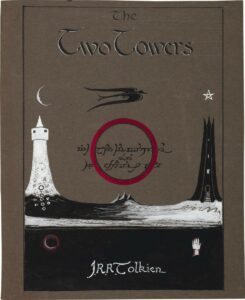
My fantasy-addled (and still groggy) mind swiftly identified two candidates. The eponymous towers of the second tome of J.R.R. Tolkien’s Lord of the Rings-trilogy.
Tolkien, the person who actually coined the term ‘mythopoesis’ or ‘mythopoeia‘ (‘myth-making’) to describe the new literary genre he was inventing replete with elves, dwarves and hobbits (though this has sadly devolved into ‘Fantasy’), identified the two towers in question as:
Minas Morgul and Orthanc .
Both towers used to belong to the forces of Good in the world of Middle-Earth. Minas Morgul had a past as a Gondor fortress originally named Minas Ithil or Tower of the Moon. Its once shining splendour had turned into a eerie spectral glow under the dominion of the Witch King of Angmar and the Nazgûl.

Orthanc ( ‘Mount Fang’ or ‘Cunning Mind’ ) had also belonged to the men of Gondor, but had fallen into Saruman’s hands.
With him in charge, the black stone fortress was now a breeding ground for orcs and, for a time, a prison for Gandalf the Grey.
So, two corrupted towers from a famous modern myth. Manifestations of Good turned Evil. Was that it? No, I was missing something. My mind wandered further and I recalled the films by Peter Jackson. How there was a debate about whether the producers should change the title of the second movie as ‘The Two Towers’, released in 2002, could be seen as offensive to survivors of…
9/11?
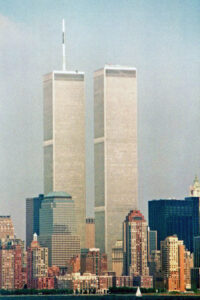
It’s weird to think that the world-shaking events of 9/11 happened two decades ago. The crumbling Twin Towers imprinted themselves on the global consciousness and hurtled us straight into the War on Terror, creating new enemies for the bellicose West and opening the flood gates for “democratic interventions” in Afghanistan and Iraq.
Were these the pillars I was looking for? As symbols of the demolition of the relatively peaceful post-Cold War era, and the start of another laced with disturbing overtones of the battle between Good and Evil, Civilization against Barbarism? Well…it’s not like we have forgotten them, rather the opposite.
Then it occured to me what they represented. The World Trade Centre. The two pillars of the global transaction of goods and currencies. Which led me to…
The dollar?
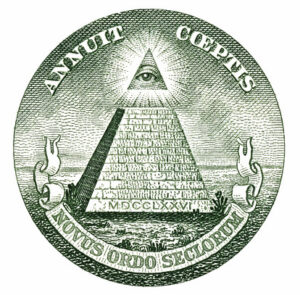
And when I say dollar, I’m not even remotely thinking about the infamous symbol of the Pyramid with the All-Seeing Eye found on the dollar bill and all that related Illuminati/Freemasonry/New Order of the Ages-jazz. Nope. I’m talking about:
$
The symbol. And how it came to be. Doesn’t sound that pillar-y, I know. But hear me out.
The prevailing theories of how the $ evolved into its current form can be summed up in the graphic below.

Dollar_Symbol_Evolution.jpg
CC BY-SA 3.0
Original picture
Either it is a conflation of U and S or a conflation of P and s. P and s? Yes. As in Pesos. Because the first Americans used Spanish currency.
I, however, don’t find any of these theories satisfactory. My money is on a a far more enticing and poetic theory that I heard from an old scholar in a brown pub in Oslo. And the clue is found in the overlap between Spanish and US coinage. In the Spanish Dólar.
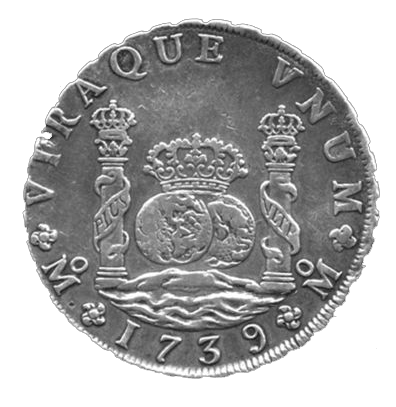
Take a good look at this silver coin, minted in Mexico in 1739. The banner snaking around the right pillar looks suspiciously like the $ sign. Variants of these coins are found with separate banners for each pillar or one banner for both, possible culprits for both the monocolumned and the bicolumned dollar sign. And there are pillars here! And two of them! What on Earth are they? Well, as it happens, they are from a very specific spot on this Earth. The promontory of Gibraltar. Could this be what I’m looking for? Is my goal the…
Pillars of Hercules?

Take another look at the Spanish Dólar above. Are you able to make out the text on the banners? It reads PLVS VLTRA. Plus Ultra. Meaning ‘Further Beyond‘.
According to Greek mythology, the tenth of Hercules’ twelve trials was to fetch the cattle of the giant Geryon who lived in the farthest reaches of the West. It is believed that he went to the Strait of Gibraltar for this task, the western extremity of the known world in Antiquity. The Pillars of Hercules marking the end of the world were said to be placed on the two opposing promontories of the strait.
Maybe two pillars, now long gone, were actually raised there, or maybe they were just symbolic representations in the mythological imagination. In any case, the pillars, real or conceptual, were said to be inscribed with the adage: NON PLVS VLTRA.
Nothing further beyond.
Then came Columbus and the “discovery” of the Americas. The great Unknown had been unveiled. And the pillars reappeared in the collective field, now with the motto: PLVS VLTRA.
So is that it? Two pillars symbolizing the border between the Known and the Unknown, warning travellers to stay back, but still silently promising untold riches to the one brave enough to cross the line? No, I have to go further back. I can feel it in my bones. The pillars still echoing in the dollar sign speak of limitless expansion, but they used to signal limitation. A border and a frame. A prison. Which reminds me of Hercules’ Judaic counterpart. The magnificent…
Samson?
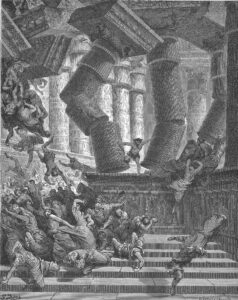
When the biblical strongman fell in love with Delilah she tricked him into cutting his long locks, shearing off his source of strength in the process. Imprisoned by the Philistines, he endured months of captivity before being paraded into the temple of Dagon to be jeered at by the locals.
Tired, he was allowed to lean himself against the two main supporting pillars of the temple. His hair had regrown and with a burst of allmighty strength channelled directly from YHWH (and his own glorious hair) he toppled the columns, killing everyone under its roof, himself included.
Are these, then, the pillars? Foundations supporting the continued existence of unjust structures, ready to be toppled by someone with a clear sense of purpose, mission, will? Is the dichotomy in question Slavery and Freedom?
I feel I am running in circles.
And then it dawns on me. I have forgotten the Roman numerals. The pillars of my dream were embossed with the number: ‘II’. And I remember. The…
Tarot?
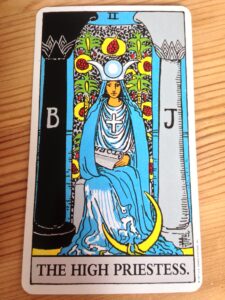
I rifle through my Tarot deck and find card number “II” in the Major Arcana. The High Priestess. Conveniently placed between two pillars. Jackpot. Ok, so I found them. But what now? What are these pillars? And why are they called B and J ?
The High Priestess herself represents intuition and the wisdom of the felt senses, that archetypally feminine knowing that is so marginalised in our present culture. She is the card of the mystic, the seer, the deep meditator, the keeper of esoteric secrets. And the letters indicate the names of the two pillars of which she is the centre.
Boaz and Jachin . The pillars standing outside the…
First Temple?
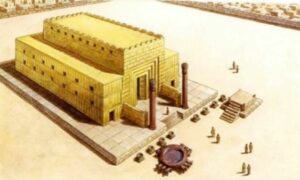
The Temple of Solomon, also known as The First Temple, was completed in 957 BC. This was the Jewish Holy of Holies until it was destroyed by the Babylonian king Nebuchadnezzar approximately 400 years later.
According to Biblical legend, this Temple housed the Ark of the Covenant, which, according to Ethopian tradition, was rescued before the sacking of Jerusalem and transported to the African mainland. It is purported to still exist in a church in Aksum, guarded by a secretive brotherhood of monks.
The Second Temple was rebuilt in 515 BC, but this version lacked the free-standing pillars in front of the entrance. These bronze and brass behemoths had been broken down for parts by the Babylonians and were never recreated. According to the Bible, this is what they looked like:
21 And concerning the pillars, the height of one pillar was eighteen cubits; and a fillet of twelve cubits did compass it; and the thickness thereof was four fingers: it was hollow.
22 And a chapiter of brass was upon it; and the height of one chapiter was five cubits, with network and pomegranates upon the chapiters round about, all of brass. The second pillar also and the pomegranates were like unto these.
23 And there were ninety and six pomegranates on a side; and all the pomegranates upon the network were a hundred round about.
First of all, that’s a lot of pomegranates. Secondly, translating these measurements into the metric system, we get a couple of giants 1.8 metres thick and 8.2 metres tall. And, as the Bible also informs us:
And he [Solomon] reared up the pillars before the temple, one on the right hand, and the other on the left; and called the name of that on the right hand Jachin, and the name of that on the left Boaz.
Like the pillars of Hercules (Non Plus Ultra), the pillars of the First Temple were said to be inscribed with these corresponding words by the Temple’s master architect Hiram Abif himself. In Hebrew of course. But what do they mean?
בֹּעַז and יָכִין ?
The Internet, being the Internet, is full of theories about these names. The scholarly consensus seems to be that בֹּעַז (Boaz) means Strength while יָכִין (Jachin) means He (God) will establish.
These words and concepts are interpreted further in a myriad of possible ways. They stand for Severity and Mercy. Or Personality and Mathematics. Or Concrete and Abstract. Or Love and Unity. Concepts both opposite and complementary. They are all these things and none, maybe even symbolic representations of King Solomon and King David, two contrasting patriarchs of the Jewish faith.
And if we look further, to Jewish mysticism, to the Kabala, this image appears:
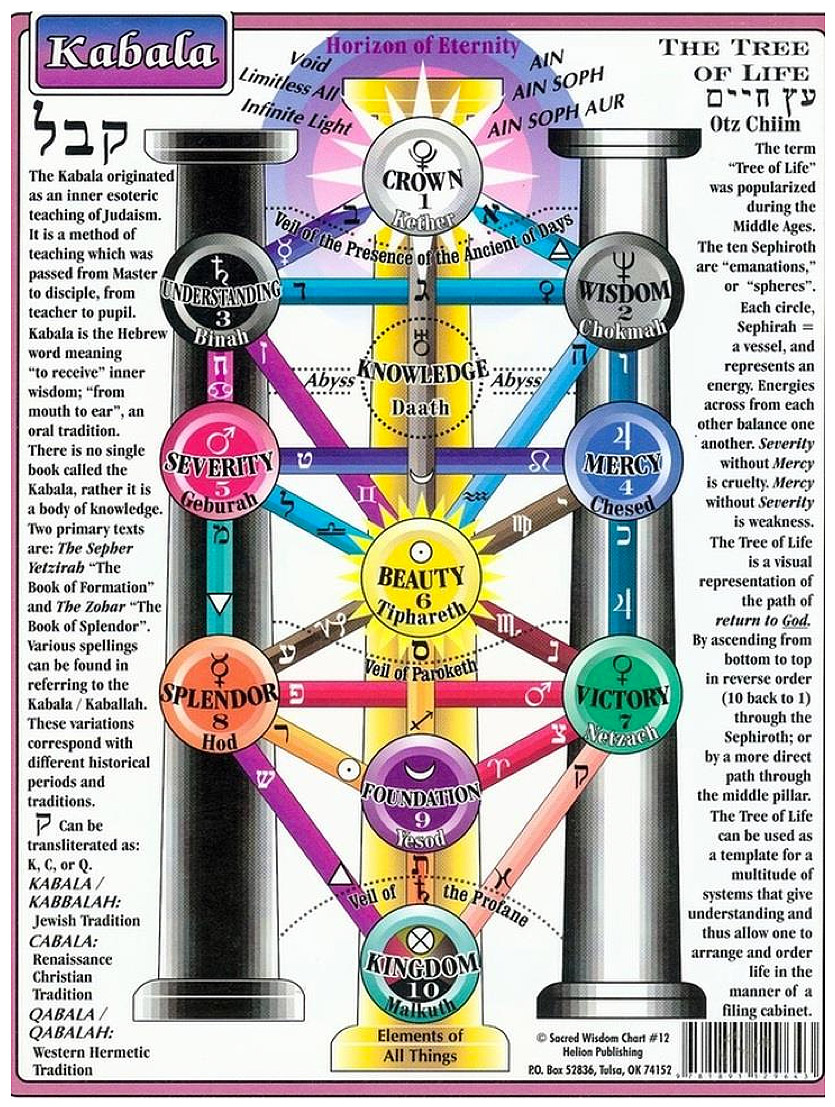
Here the two pillars are seen as the ‘legs of God’, pillars of the Tree of Life itself, and important points of balance to reach back to the Divine from whence we emanate. The central pillar shown here; the golden, ethereal one; can be termed ‘The Pillar of Balance’ in between the pillars of Severity (Boaz) and Mercy (Jachin). In the First Temple there was, of course, no central column. But there was a central fire.
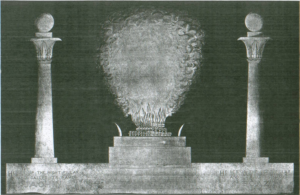
‘When Solomon finished praying, fire came down from heaven and consumed the burnt offering and the sacrifices, and the glory of the Lord filled the temple.
The priests could not enter the temple of the Lord because the glory of the Lord filled it.
When all the Israelites saw the fire coming down and the glory of the Lord above the temple, they knelt on the pavement with their faces to the ground, and they worshipped and gave thanks to the Lord, saying, For he is good; for his mercy endureth for ever’
This inextinguishable imperishable fire (probably helped along by the consummate attention of the priesthood, as is still the case in Zoroastrian temples with ever-lasting fires in Iran) represented the essence of the Divine in the trinity of the First Temple’s main concepts – Boaz, Jachin and the Fire enshrined in the Ark of the Covenant. Which would find a later reincarnation in the Christian trinity of Son, Father and Holy Ghost.
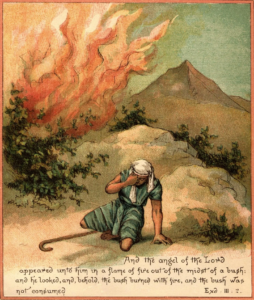
When we think about fires in the Old Testament, the First Temple probably doesn’t pop up first, though. That honour is reserved for the burning bush that visited Moses. The bush that burned with fire, but which ‘was not consumed’.
This awe-inspiring apparition, when asked by Moses, gave its name as:
I AM WHO I AM
I AM?
This response – I am who I am – reminds me of the Upanishads, the old Vedic sacred texts, and the phrase तत् त्वम् असि ( Tat tvam asi ) meaning:
THOU ART THAT
In a sense, the answer to everything is that you are everything. In this sentence lies the core of the relationship between absolute reality and the individual limited being.
Thou art that. I am. I am who I am.
I have pondered these phrases. I am who I am. Thou art that. And others like them.
For instance γνῶθι σεαυτόν ( Gnothi Seauton ) – Know thyself – the inscription found at the temple of Apollo at Delphi.
They have been simmering in the borderlands of my consciousness for years as if I knew that they spoke of something true, yet ineffable. And then, in communion with the spirit of ayahuasca (an experience you can read about in further detail in The Unbearable Everything) I had many visions, one of which I will repeat and paraphrase briefly here. The beginning, or rather, a perspective of the beginning.
The only Being, the Mind, becoming self-aware in a shock of epic proportions. The Bible tells us ‘And in the beginning was the word and the word was God’. Another way of saying God is of course I AM. Hence, in the beginning, in the awe, joy and terror of primal self-realization, Being said to itself:
I AM?
And with that the Unity of All was split and fragmented and reality itself was created from that question, polarities and opposites emerging in the mix, a cell division like no other.
And here it is – I have found it. Another vision. Of a gate with two sturdy pillars and a pure white light that splits, refracts, as it passes between the two pillars and becomes the entire spectrum of the rainbow. Reality unfolding itself in all its spectral glory confined by the pillars representing the opposite poles of the All.
The Pillars of Polarity.
Light and Darkness. Yin and Yang. Boaz and Jachin. I and AM.
Ok. I don’t think I can get any deeper than this. So let’s return to the original unasked plea:
You have forgotten us. You have to remember us.
How to extrapolate? How to widen this vision? In the centre, in between the pillars, is the fire, the Unity. The alchemical symbol of fire is simply:
🜂
So a stylistic interpretation of this entire image is
|🜂|
Ok. But in today’s society, there is little to no sense of Unity. Everyone has their own interpretation of the central concept from which these pillars emanate, whether it be Allah or the Big Bang or Chaos or Brahma. In fact, the central fire has been upended and lost its foundation, which leaves us with:
|>|
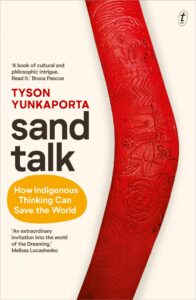 …which in mathematical lingo would mean that one pillar is ‘greater than’ another. This reminds me of Tyson Yunkaporta, a Queensland academic who is part of the indigineous Apalech clan. In his fabulous book “Sand Talk: How Indigineous Thinking can Save the World” he shares a Dreaming story of the beginning of the world:
…which in mathematical lingo would mean that one pillar is ‘greater than’ another. This reminds me of Tyson Yunkaporta, a Queensland academic who is part of the indigineous Apalech clan. In his fabulous book “Sand Talk: How Indigineous Thinking can Save the World” he shares a Dreaming story of the beginning of the world:
“There are a lot of stories that explain how all this began… My favorite one comes from Nyoongar Elder Noel Nannup in Perth, who tells the Dreaming story of a meeting in which all the species sat down for a yarn to decide which one would be the custodial species for all of creation. Emu made a hell of a mess, running around showing off his speed and claiming his superiority, demanding to be boss and shouting over everyone.”
Yunkaporta further ties the image of the Emu to the open “me-me-me”-beak of the symbols “>” and “<“:
“Emu’s problem can be seen in the mathematical greater-than/less-than interpretation of the symbol. Emu is a troublemaker who brings into being the most destructive idea in existence: I am greater than you, you are less than me. This is the source of all human misery”
From the very first time Emu opened its beak, humanity was severed from its source. Instead of seeing Polarity as an expression of Unity, we became enmeshed and trapped in the perception of Duality as a conflicting force, where the only way to acheive Unity is to destroy the other pole or convince it to change its charge to your own. At the same time, paradoxically, we need to stay in Duality and to have our dream of Utopian Unity unfulfilled to remain snugly seated in our seat of superiority that created the problem to begin with.
I am greater than you. You are less than me. This is seen in all human interaction all across the globe. This idea informs capitalism and the self-proclaimed rights of billionaires vs. lowly workers and “useless eaters”. Racism, sexism, species-ism and all other -isms. We see it in the Culture Wars ravaging especially the US, where the two poles are so far apart that they in extremis see the other as inhuman and immoral, not understanding that they are both possessed by Emu, firmly insisting on their position as the only acceptable one, the only way towards unity. Their pillar is Good, the other’s pillar is Evil.
This is, incidentally, how that looks like:
|><|
It is hard to avoid the plague of Emu and the virus of unconsciousness that it introduced to the world. I mean, writing this, the Emu in me tells me that I am superior for having figured this out. Ye Gads. Is it possible to live in a polar existence without superiority or inferiority? Well, magnets can do it.
Which spurs me to introduce a tiny bit of levity to get a breather, from Insane Clown Posse’s wonderfully un-ironic music video “Miracles”:
That aside aside, even if all of us do not necessarily know exactly how magnets work, can we emulate their example? Can we remember that polarity is a necessity for existence itself, and try to, I don’t know, abandon the Good/Evil-dichotomy of Duality and live in a sense of Unified Polarity?
Can we somehow try to rebuild the First Temple, not as a physical structure, but in our hearts, remembering that Mercy without Severity is Weakness and Severity without Mercy is Cruelty. Thus spurring us to do what Samson did, but in reverse, to not topple the pillars, but to topple ourselves, turning our beaks towards each other in a gesture similar to this:
|<>|
reaching out to talk to one another, to try to see the Other. And though this seems a Herculean effort, the reward is greather than we could imagine. For we realise that we have been saying NON PLVS VLTRA about each other for far too long, but here, between the pillars, we understand that The Strait of Gibraltar is not the end, there is more beyond. A continent’s worth. PLVS VLTRA. The Other is not the Enemy. The Other is but another You. Your Twin Tower. And it is then we understand that when seen again, this:
|<>|
is not two beaks at all, it is a shared, central eye. And that our vision, like the eye of Sauron, has been sick and corrupted for far too long, for we remember that both towers, Minas Morgul and Orthanc, once were good and pure. They had just forgotten who they were. For, there, in the centre of it all, in the position of the High Priestess underneath the II, through connecting to our intuiton and our inner knowing, we see the core of the third golden pillar of the Tree of Life: The realm of TIFERET or Beauty.
The Beauty in the Eye of the Beholder.
|=|